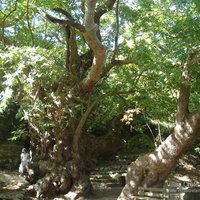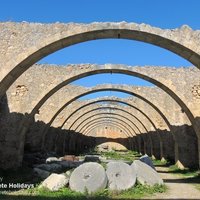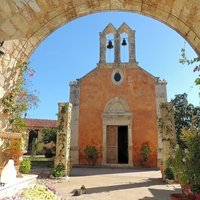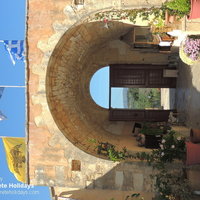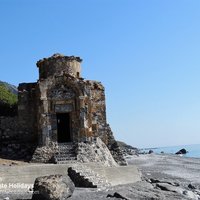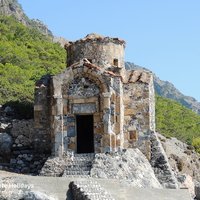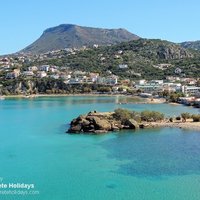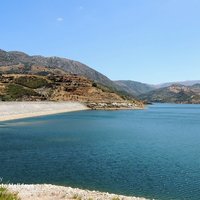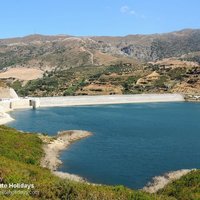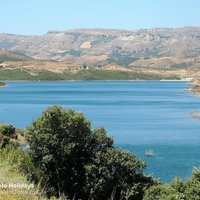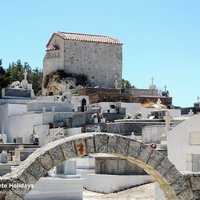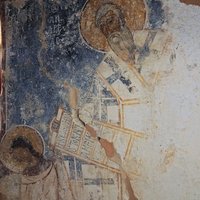Crete has everything you that could possibly want from a holiday: soaring mountains that are snow capped from November to June, many great walking trails including Europe's deepest gorge, ancient archaeological sites and Minoan palaces, quaint villages, sparkling clear blue seas with tavernas serving freshly caught fish, golden beaches, glorious wild flowers in the Spring and a variety of delicious foods which are made from healthy, home grown produce.
As incredible as the island is, it is the Cretan people who will make your holiday truly memorable. Descendants of the Minoan's, one of Europe's earliest civilizations, and shaped by centuries of struggle against oppression, the Cretans are as rugged as the mountains, fiercely independent but passionately friendly.
Most of our villas are located in the heart of The Apokoronas Region just east of the beautiful town of Chania . With its stunning Venetian harbour, quayside bars and restaurants, what better place to relax and watch the world go by. In the narrow streets behind Chania 's harbour you will find tavernas, bars, “leather lane”, the famous covered market, and many local shops selling the multitude of handicrafts that Crete is famous for including textiles such as hand made lace and woven blankets, jewellery, hand made ceramics, and bargain leather goods.
Crete is classed as being the most southerly point of Europe which means that it enjoys a longer summer season than anywhere else in Greece. It is situated 260 miles from Athens the Greek capital, and 187 miles from the African continent. The climate of Crete is a temperate Mediterranean climate and the weather is characterized by long hot, dry summers and mild winters. The spring can be warm and sunny during the day but still have cooler evenings and is perfect for walking, bird watching and looking at the acres of brightly coloured wild flowers.
Greece has more islands than any other country in the world. Crete is the largest of all the Greek islands and the fifth largest in the Mediterranean. It measures approximately 170 miles in length, 35 miles at its widest point and only 12 miles at its narrowest point. It is the most southerly point of Europe. It has a population of approximately 640, 000 and is split into four prefectures or counties: Lasithi, Heraklion , Rethymnon and Chania .
All of the big towns are situated on the northern coast of the island. Ierapetra is the only port of any size on the southern side of the island, on the shores of the Libyan sea. Heraklion is the fifth largest city in Greece and has been the capital of Crete since 1971. The second biggest city is Chania , Chania or Xania, which used to be the capital of Crete , and is reputed to be the oldest city in the world, dating back to Neolithic times. The third biggest is Rethymnon , and like Heraklion and Chania , it has a very beautiful area known as the “old town” which was predominately built by the Venetians and features a port.
Crete has two major features which distinguishes it from the other islands. One is the range of the White Mountains which covers two thirds of the island and the other is its ancient history. For any visitor, no matter how ardent a sun-worshipper, it is impossible to avoid either. The mountains stretch along the centre, like the backbone of the island, from east to west. There are three ranges housing over 3000 caves. These are the Dikti in the east with summits of over 7000 feet, in the centre of the island there is the Idi or Psiloritis range with Mount Ida at 8054 feet, Mount Ida just wins the title of the highest peak, beating Pachnes at 8045 feet in the western range of the Lefka Ori (White Mountains) by a mere 9 feet. The peaks of all these mountains are snow capped from November until May/June, and in spring time make a lovely backdrop when the wild almond trees are in blossom and a profusion of wild flowers appears. Crete has an amazing array of over one thousand different types of plants and trees and there are some 1500 different varieties of wild flowers with 10% of these being indigenous to Crete . This includes wild tulip, cyclamen, and 20 different types of orchid.
The mountain tops are also the home of the Cretan wild goat the Kri Kri. There are 250 different types of birds to be found on the island, some of them merely visitors to these shores. Bonelli’s eagle and Eleanor’s falcon are also to be found here. The logger head turtle can be seen in many places on Crete and they lay their eggs on some of the island’s pristine sandy beaches. Many visitors delight in feeding the turtles that can be found at Agia reservoir, Lake Kournas, and the river at Georgioupolis . The mountainous fertile plateaus are split by deep gorges such as the gorge of Samaria. This is Europe’s longest at 11 miles or 16 kilometers long. It is now a National Park and also one of the refuges for the Kri Kri. Crete has many fertile plains and valleys (Amari is one of the most beautiful) and the scenery is constantly changing. In one area Crete can be harsh and barren, in another wooded and gentle, with the palm tree forests at Prevelli and Vai and the cedar forests on the small south islands of Gavdos and Hrissli, and in the Apokoronas area near Vrisses . In ancient times the whole island was covered in forests. But these have been cut down over the years for shipbuilding purposes, by the various occupying forces.
The coastline also has incredibly varied areas, with often in-accessible steep mountain cliffs with jagged rocks, or numerous golden sandy beaches. You can still see old farmhouses, many old churches and monasteries, some, long forgotten, on the steep slopes, and rustic old villages where time seems to have stood still.
The island boasts some thirteen million olive trees, orange and lemon groves and grape vines. Other fruit that grow here are bananas, apples, grapefruit, pears and quince. The quince is thought to have originated in Crete . Its Latin name “Kydonia” was the ancient name for Chania . Now, with the arrival of plastic greenhouses, tomatoes are grown all over the island. Other vegetables grown in abundance on Crete include cucumbers, potatoes, pumpkins, aubergines, courgettes, peppers and a variety of different beans. Crete ’s main exports are olives and olive oil, fruit (mainly grapes, citrus fruits, tangerines, melons, water melons, kiwis, avocadoes and bananas), wine (the production of which dates back to 2000 B.C.) and sultanas, exporting over 10 000 tonnes of sultanas, 30% of it’s olive oil, and some 15% of it’s wines. An incredible variety of herbs are grown in Crete including oregano, thyme and labdanum. Many of these are collected, dried and sold to the local market and abroad. One of the most famous is Diktamo or Dittany. This is named after Mount Dikti in the East and is usually served as an herb tea to soothe all ailments. Saffron is also a very good buy as it is so inexpensive compared to UK prices. The honey of Crete is completely natural, is rich in vitamins and anti-oxidants, and has been produced on the island since pre-historic times. The island’s rich vegetation and herbs are the favourite source of food for bees and it is easy to understand why Crete produces the most aromatic honey in the world.
The other distinguishing feature of the island is its turbulent history, which you can read about in detail in the history section of this website. Crete been invaded and occupied by foreign forces many times in its history, all of whom have left their mark on the island. Therefore there is a wealth of outstanding archaeological sites ranging from elaborate Minoan palaces such as Knossos and Phaistos, to Roman aqueducts, to Byzantine chapels with mosaic floors, to Venetian fountains, town houses, ports, and small chapels with ornate frescoes, and to impregnable Turkish forts. Even the German occupation during World War 2 has left a lasting impression with the beautiful, serene and immaculate site of the Allied War Cemetary in Souda Bay, and The German Cemetery which is very near to where the actual invasion started, and overlooking the all important Maleme airstrip. A visit to either of these cemeteries is an incredibly moving experience.
Today an invasion of a very different kind is encouraged by the Cretans. Some 1.5 million visitors every year are discovering the infectious hospitality and friendship of the Cretan people. They are experiencing the rich culture, history and natural beauty of the island that seems to attract the visitor back to this island of contrasts again and again.
Whatever type of holiday you are looking for, Crete can fulfill your needs and will exceed your expectations. You have the choice to relax on a sun bed next to your pool or on one of Crete ’s beautiful beaches, or you can get out into the incredibly varied countryside and take in the stunning scenery, or you can indulge in one of the many activities available on Crete . You may even choose to do a little bit of everything. All in all Crete is absolutely perfect for your villa holiday.
